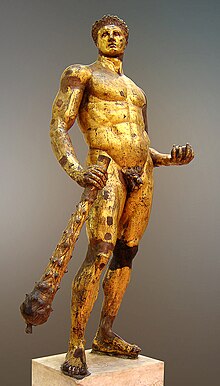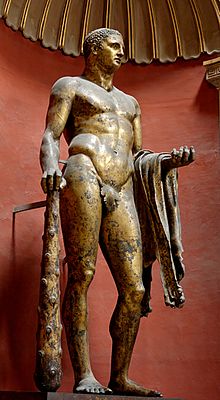Hercules

Hercules is the Roman name for the mythical Greek demigod Heracles, son of Jupiter (the Roman equivalent of Zeus), and the mortal Alcmena. Early Roman sources suggest that the imported Greek hero supplanted a mythic Italic shepherd called "Recaranus" or "Garanus", famous for his strength, who dedicated the Ara Maxima that became associated with the earliest Roman cult of Hercules.[1] While adopting much of the Greek Heracles' iconography and mythology as his own, Hercules adopted a number of myths and characteristics that were distinctly Roman. With the spread of Roman hegemony, Hercules was worshiped locally from Spain through Gaul.
Etymology
Hercules's Latin name is not directly borrowed from Greek Heracles but is a modification of the Etruscan name Hercle, which derives from the Greek name via syncope, Heracles translates to "The Glory of Hera". An oath invoking Hercules (Hercle! or Mehercle!) was a common interjection in Classical Latin.[2]
Character
In Roman works of art and in Renaissance and post-Renaissance art that adapts Roman iconography, Hercules can be identified by his attributes, the lion skin and the club: in mosaic he is shown tanned bronze, a virile aspect.[3] While he was a champion and a great warrior, he was not above cheating and using any unfair trick to his advantage. However, he was renowned as having "made the world safe for mankind" by destroying many dangerous monsters. His self-sacrifice obtained him the ascent to the Olympian realms and he was welcomed by the gods.
Roman cult

In their popular culture the Romans adopted the Etruscan Hercle, a hero-figure that had already been influenced by Greek culture — especially in the conventions of his representation — but who had experienced an autonomous development. Etruscan Hercle appears in the elaborate illustrative engraved designs on the backs of Etruscan bronze mirrors made during the fourth century BC, which were favoured grave goods. Their specific literary references have been lost, with the loss of all Etruscan literature, but the image of the mature, bearded Hercules suckling at Uni/Juno's breast, engraved on a mirror back from Volterra, is distinctively Etruscan. This Hercle/Hercules — the Hercle of the interjection "Mehercle!" — remained a popular cult figure in the Roman legions.
The literary Greek versions of his exploits were appropriated by literate Romans from the 2nd century BCE onwards, essentially unchanged, but Latin literature of Hercules added anecdotal detail of its own, some of it linking the hero with the geography of the Western Mediterranean. Details of the Greek cult, which mixed chthonic libations and uneaten holocausts with Olympian services, were adapted to specifically Roman requirements as well, as Hercules became the founding figure of Herculaneum and other places, and his cult became entwined with Imperial cult, as shown in surviving frescoes in the Herculanean collegium. His altar has been dated to the 5th or 6th century BC. It stood near the Temple of Hercules Victor. Hercules became popular with merchants, who customarily paid him a tithe of their profits.
Marcus Antonius identified himself with Hercules, and even invented a son of Hercules, called Anton, from whom Antonius claimed descent. In response, his enemy Octavianus identified with Apollo. Some early emperors took up the attributes of Hercules (e.g. Traianus), and later Roman Emperors, in particular Commodus and Maximian, went further and often identified or compared themselves with him and supported his cult; Maximianus styled himself "Herculius". The cult of Hercules spread through the Roman world. In their gardens, wealthy Romans would often build altars to Hercules, who was regarded as the benefactor of mankind.[5] In Roman Egypt, what is believed to be the remains of a Temple of Hercules are found in the Bahariya Oasis.
The Romans adopted the myths of Heracles including his twelve labors, essentially unchanged, but added anecdotal detail of their own, some of it linking Hercules with the geography of the Western Mediterranean.
In Roman mythology, Acca Larentia was Hercules's mistress. She was married to Tarutius, a wealthy merchant. When he died, she gave his money to charity. In another version, she was the wife of Faustulus.
In Aeneid 8.195ff., Vergilius relates a myth about Hercules' defeating the monstrous Cacus, who lived in a cave under the Palatine Hill (one of the eventual Seven Hills of Rome).
Death of Hercules
Hercules was married to Deianeira. Long after their marriage, one day the centaur Nessus offered to ferry them across a wide river that they had to cross. Nessus set off with Deianeira first, but tried to abduct her. When Hercules realized the centaur's real intention, Hercules chased after him and shot him with a poisoned arrow. Before he died Nessus told Deianeira to take some of his blood and treasure it: if she ever thought Hercules was being unfaithful, the centaur told her, the blood would restore his love. Deianeira kept the phial of blood. Many years later after that incident she heard rumours that Hercules has fallen in love with another woman. She smeared some of the blood on a robe and sent it to Hercules. When he put on the robe, the blood still poisoned from the same arrow used by Hercules, burnt into his flesh and when he realized this, he told his friends to build him a pyre out of hardy oak and wild olive. He was burnt to death on the pyre, the fire hurt far less than the poison. His father Jupiter then turned him into a god.
Germanic association
Tacitus records a special affinity of the Germanic peoples for Hercules. In chapter 3 of his Germania, Tacitus states:
... they say that Hercules, too, once visited them; and when going into battle, they sang of him first of all heroes. They have also those songs of theirs, by the recital of this barditus[6] as they call it, they rouse their courage, while from the note they augur the result of the approaching conflict. For, as their line shouts, they inspire or feel alarm.
In the Roman era Hercules' Club amulets appear from the 2nd to 3rd century, distributed over the empire (including Roman Britain, c.f. Cool 1986), mostly made of gold, shaped like wooden apples. A specimen found in Köln-Nippes bears the inscription "DEO HER[culi]", confirming the association with Hercules.
In the 5th to 7th centuries, during the Migration Period, the amulet is theorized to have rapidly spread from the Elbe Germanic area across Europe. These Germanic "Donar's Clubs" were made from deer antler, bone or wood, more rarely also from bronze or precious metals. They are found exclusively in female graves, apparently worn either as a belt pendant, or as an ear pendant. The amulet type is replaced by the Viking Age Thor's hammer pendants in the course of the Christianization of Scandinavia from the 8th to 9th century.
Art
Roman images of Hercules were based upon Hellenistic Greek images and might be contrasted with the images of Hercules that appear in Attic vase-painting (see Heracles). One aspect of Heracles' iconography that did not carry over to that of Hercules was his use of a bow.
Gallery of ancient interpretations
-
Hercules frescoes in the collegium at Herculaneum
-
Statutes of a religious association in Roman-era Greece whose members worshipped Hercules
Hercules in popular culture
Since the Renaissance, Heracles has rarely been distinguished from Hercules, the Roman figure overshadowing the Greek. Later interpretations of Hercules' legend cast him as a wise leader and a good friend (many of the movie and TV adaptations cast him in this light, especially the 1995–1999 syndicated TV series). He was the main star in the Disney animated movie of the same name, on which the TV series is based.
The legend of Hercules endures, though often co-opted to suit the political fashion of the day. Hercules has also had an undeniable influence on modern pop culture characters such as Superman and He-Man. The legend of Hercules has been described in many movie and television adaptations, including several comic series featuring the hero. Hercules has been the hero of both Marvel Comics (where the rendition of Hercules was an early member of the Avengers) and DC Comics adventure comic books. In DC, he has often been associated with Wonder Woman. In Marvel, he currently stars in his own ongoing series titled The Incredible Hercules, where he has dealt with Amadeus Cho, the Hulk, the Eternals, and others.
Hercules in numismatics
Hercules has been the main motif of many collector coins and medals, the most recent one is the famous 20 euro Baroque Silver coin issued in September 11, 2002. The obverse side of the coin shows the Grand Staircase in the town palace of Prince Eugene of Savoy in Vienna, currently the Austrian Ministry of Finance. Gods and demi-gods hold its flights, while Hercules stands at the turn of the stairs.
Gallery of modern interpretations
-
Hercules and the Hydra by Antonio del Pollaiuolo, 15th century.
-
Austrian commemorative coin featuring Hercules.
-
Hercules used as a heraldic supporter in the Coat of arms of the Kingdom of Greece, in use from 1863 to 1973. Greek royalists were sometimes mockingly called "Ηρακλείδες" ("the Herculeses").
See also
Notes
- ^ Servius, commentary on the Aeneid viii. 203, 275 ; Macrobius, Saturnalia iii. 12.
- ^ W. M. Lindsay, "Mehercle and Herc(v)lvs. [Mehercle and Herc(u)lus]" The Classical Quarterly 12.2 (April 1918:58).
- ^ The Classical and Hellenistic conventions of frescoes and mosaics is to show women as pale-skinned and men as tanned dark from their outdoor arena of action and exercising in the gymnasium.(See also [1] and [2]).
- ^ The sculpture had been carefully buried in Antiquity, having been struck by lightning.
- ^ Martial, book VII
- ^ or, baritus, there being scribal variants. In the 17th century, the word entered the German language as barditus and was associated with the Celtic bards.








